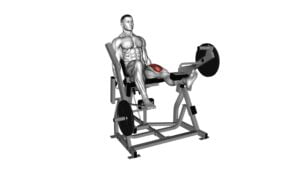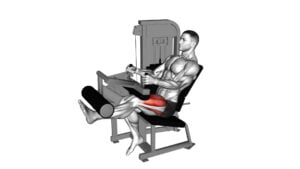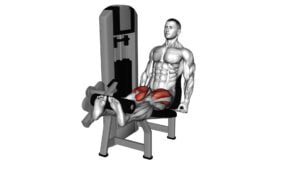Lever One Leg Extension – Video Exercise Guide & Tips

Are you looking to strengthen and tone your legs? Look no further than the Lever One Leg Extension exercise.
Watch This Exercise Video
This video exercise guide will provide you with step-by-step instructions and useful tips to ensure proper form and maximum results.
With just a few minutes a day, you can target your quadriceps and improve your lower body strength.
Get ready to feel the burn and see the results with this effective leg exercise.
Key Takeaways
- Lever one leg extension targets the quadriceps for increased muscle strength and definition.
- It utilizes resistance to challenge muscles and promote growth.
- Proper form and technique are important to prevent injury and maximize benefits.
- Modifications and progressions can be made to increase intensity and engage muscles further.
Benefits of Lever One Leg Extension
Get ready to experience the many benefits of the Lever One Leg Extension exercise. This exercise is designed to target your quadriceps, helping you to increase muscle strength and improve muscle definition. By isolating one leg at a time, you can focus on the specific muscles of that leg, allowing for a more targeted workout.
The Lever One Leg Extension is an effective exercise for increasing muscle strength. By utilizing resistance, this exercise forces your quadriceps to work harder, leading to muscle growth and improved strength. As you increase the resistance over time, you'll continue to challenge your muscles and see even greater results.
In addition to increased muscle strength, the Lever One Leg Extension also helps to improve muscle definition. By isolating the quadriceps, you can specifically target this muscle group and enhance its shape and definition. As you continue to perform this exercise regularly, you'll notice your quadriceps becoming more defined and sculpted.
Incorporating the Lever One Leg Extension into your workout routine can provide you with the benefits of increased muscle strength and improved muscle definition. So, get ready to take your leg workout to the next level with this effective exercise.
Proper Form for Lever One Leg Extension
To ensure proper form for the Lever One Leg Extension exercise:
- Maintain a stable position and engage your core throughout the movement.
- Exhale as you extend your leg and inhale as you bring it back to the starting position.
- Be aware of common injuries that can occur during the exercise:
- Hyperextension of the knee: Keep a slight bend in your knee and avoid locking it out.
- Lower back strain: Engage your core muscles and maintain a neutral spine position.
By following these tips and maintaining proper form, you can maximize the benefits of the Lever One Leg Extension while minimizing the risk of injury.
Now, let's move on to discuss the equipment needed for this exercise.
Equipment Needed for Lever One Leg Extension
Now let's move on to the equipment you'll need for the Lever One Leg Extension exercise. To perform this exercise effectively, you'll require the following:
- Lever Leg Extension Machine: This is the primary equipment needed for the Lever One Leg Extension exercise. The machine typically consists of a seat, a lever arm, and weight plates. Adjust the seat height and position the lever arm according to your comfort and range of motion.
- Weight Plates: These are used to add resistance to the exercise. Start with a weight that challenges you but still allows you to maintain proper form. Gradually increase the weight as you progress to continue challenging your muscles.
- Ankle Strap: Some lever leg extension machines may require you to attach an ankle strap to your leg. This strap helps secure your foot to the lever arm, providing stability and control during the exercise.
- Towel or Mat: Place a towel or mat on the seat for added comfort and to prevent any discomfort caused by the machine's surface.
Modifications and Progressions for Lever One Leg Extension
Now let's explore some advanced progressions for the Lever One Leg Extension exercise. By incorporating these variations, you can challenge yourself and continue to progress in your strength training journey.
Whether you're looking to increase the difficulty or make the exercise more accessible, these modifications and progressions will help you tailor the Lever One Leg Extension to your fitness level.
Advanced Progressions for Extensions
You can further challenge yourself with advanced modifications and progressions for the Lever One Leg Extension exercise. Here are four advanced variations to take your leg extensions to the next level:
- Single-leg Lever One Leg Extension: Instead of using both legs, perform the exercise with only one leg at a time. This will increase the intensity and require more stability and control.
- Weighted Lever One Leg Extension: Hold a dumbbell or ankle weight on the working leg during the exercise. The added resistance will make the movement more challenging and help build strength.
- Tempo Lever One Leg Extension: Slow down the tempo of the exercise by extending and flexing your leg at a slower pace. This will increase time under tension and enhance muscle engagement.
- Plyometric Lever One Leg Extension: Add an explosive jump at the top of the extension movement. This will activate fast-twitch muscle fibers and improve power and explosiveness.
Remember to always maintain proper form and technique throughout these advanced progressions to maximize the benefits and minimize the risk of injury.
Modifications for Beginners
If you're a beginner, there are modifications and progressions available for the Lever One Leg Extension exercise. It's important to start with the proper form techniques to avoid injury and maximize the benefits of the exercise.
As a beginner, you can begin by using a lighter weight or resistance band to decrease the intensity of the exercise. This will allow you to focus on your form and build strength gradually.
Another modification is to perform the exercise with both legs instead of one leg at a time. This will provide more stability and make it easier for beginners to maintain proper form.
Remember to listen to your body and progress at your own pace.
Common Mistakes to Avoid During Lever One Leg Extension
To maximize the effectiveness of your lever one leg extension exercise, it's crucial to avoid these common mistakes:
- Using momentum: One of the most common mistakes during a lever one leg extension is using momentum to lift the leg. This not only reduces the effectiveness of the exercise but also puts unnecessary strain on the muscles and joints. Instead, focus on controlled movements, using your muscles to lift and lower the leg.
- Arching your back: Another mistake is arching your back during the exercise. This can lead to lower back pain and discomfort. To prevent this, engage your core muscles and maintain a neutral spine throughout the movement.
- Neglecting proper alignment: It's important to maintain proper alignment during the lever one leg extension. Make sure your hips, knees, and ankles are in line with each other. Avoid letting your leg drift inward or outward, as it can lead to imbalances and potential injury.
- Overextending your knee: Lastly, avoid overextending your knee at the top of the movement. This can put excessive stress on the joint and increase the risk of injury. Instead, focus on extending your leg until it's straight, but not hyperextended.
Tips for Maximizing Results With Lever One Leg Extension
To maximize your results with the lever one leg extension, it's crucial to focus on proper form techniques. This means maintaining a stable position and controlling the movement throughout the exercise.
Additionally, make sure to target the specific muscle groups you want to work on by adjusting the seat and footplate position accordingly.
Lastly, gradually increase the weight as you progress to challenge your muscles and promote growth.
Proper Form Techniques
Use proper form techniques to maximize your results with the Lever One Leg Extension.
Follow these tips to ensure you're performing the exercise correctly:
- Maintain proper alignment: Keep your back straight, shoulders relaxed, and core engaged throughout the movement. Avoid rounding your back or arching excessively.
- Use controlled movements: Slowly extend your leg while keeping tension in your quadriceps. Avoid using momentum or swinging your leg.
- Focus on your breathing: Inhale as you lower the weight and exhale as you extend your leg. Proper breathing techniques can help you maintain stability and control.
- Prevent common injuries: To avoid straining your knee joint, make sure to use a weight that's suitable for your strength level. Start with lighter weights and gradually increase as you progress.
Targeting Muscle Groups
Maximize your results with the Lever One Leg Extension by targeting specific muscle groups. To optimize muscle activation, focus on engaging your quadriceps throughout the exercise. Keep your core stable and maintain proper form to ensure the targeted muscles are effectively worked.
Additionally, incorporating exercise variations can further enhance your results. Try adjusting the seat height or foot position to emphasize different areas of the quadriceps. For example, a lower seat position places more emphasis on the vastus lateralis, while a higher seat position targets the rectus femoris. Changing foot position, such as performing the exercise with toes pointed inwards or outwards, can also target specific areas of the quadriceps.
Gradual Weight Increase
Start by gradually increasing the weight you use for the Lever One Leg Extension exercise. This will help challenge your muscles and promote growth over time. Here are four tips to maximize your results with a gradual weight increase:
- Start with a weight that allows you to perform the exercise with proper technique. This will ensure that you're targeting the intended muscle group effectively.
- Once you can comfortably complete the desired number of repetitions with good form, add a small amount of weight. Aim for a 5-10% increase.
- Repeat this process every 1-2 weeks, gradually increasing the weight as your strength improves.
- Be mindful of any signs of discomfort or pain during the exercise. If you experience any, reduce the weight or seek guidance from a fitness professional to ensure proper technique and avoid injury.
Frequently Asked Questions
Can I Perform the Lever One Leg Extension Exercise if I Have a Knee Injury?
Yes, you can perform modified leg exercises if you have a knee injury.
It's important to avoid putting excessive strain on the injured knee.
Instead of the lever one leg extension exercise, you can try alternative exercises that are gentler on the knee, such as seated leg extensions or lying leg curls.
These exercises can help strengthen your leg muscles without aggravating your knee injury.
Remember to consult with a healthcare professional for personalized advice.
How Many Sets and Repetitions Should I Do for the Lever One Leg Extension Exercise?
To determine the number of sets and repetitions for the lever one leg extension exercise, consider your fitness level and goals.
It's important to start with a weight that challenges you but allows for proper form. Beginners can modify the exercise by using lighter weights or performing fewer reps.
Common mistakes to avoid include using momentum and not fully extending the leg.
Remember to consult with a fitness professional for personalized guidance.
Can I Use Ankle Weights or Resistance Bands to Make the Lever One Leg Extension Exercise More Challenging?
Yes, you can definitely use ankle weights or resistance bands to make the lever one leg extension exercise more challenging. Adding ankle weights or resistance bands will increase the resistance and intensity of the exercise, helping to strengthen your leg muscles even more.
However, it's important to start with lighter weights or resistance bands and gradually increase as you get stronger to avoid injury. Always consult with a fitness professional to ensure proper form and technique.
Is It Normal to Feel a Burning Sensation in My Quadriceps During the Lever One Leg Extension Exercise?
Feeling a burning sensation in your quadriceps during the lever one leg extension exercise is actually quite normal. This sensation is a result of muscle activation and indicates that your quadriceps are working hard.
It's important to listen to your body and work within your comfort level. If the burning sensation becomes too intense or painful, you may need to reduce the resistance or take a break.
Always prioritize safety and proper form during your workouts.
Can I Incorporate the Lever One Leg Extension Exercise Into a Full Leg Workout Routine?
Yes, you can definitely incorporate the lever one leg extension exercise into your full leg workout routine. It targets your quadriceps and helps to strengthen and tone your legs.
However, it's important to note that this exercise may not be suitable for everyone, especially if you have any knee or lower back issues.
If that's the case, there are alternative exercises you can try, such as squats or lunges, that also engage your quadriceps effectively.
Conclusion
In conclusion, the lever one leg extension is a beneficial exercise for strengthening and toning the legs.
By maintaining proper form and using the necessary equipment, you can maximize your results and avoid common mistakes.
With modifications and progressions, you can challenge yourself and continue to progress.
Incorporating this exercise into your fitness routine can help you achieve your leg strength and toning goals.

Author
Years ago, the spark of my life’s passion ignited in my mind the moment I stepped into the local gym for the first time. The inaugural bead of perspiration, the initial endeavor, the very first surge of endorphins, and a sense of pride that washed over me post-workout marked the beginning of my deep-seated interest in strength sports, fitness, and sports nutrition. This very curiosity blossomed rapidly into a profound fascination, propelling me to earn a Master’s degree in Physical Education from the Academy of Physical Education in Krakow, followed by a Sports Manager diploma from the Jagiellonian University. My journey of growth led me to gain more specialized qualifications, such as being a certified personal trainer with a focus on sports dietetics, a lifeguard, and an instructor for wellness and corrective gymnastics. Theoretical knowledge paired seamlessly with practical experience, reinforcing my belief that the transformation of individuals under my guidance was also a reflection of my personal growth. This belief holds true even today. Each day, I strive to push the boundaries and explore new realms. These realms gently elevate me to greater heights. The unique combination of passion for my field and the continuous quest for growth fuels my drive to break new ground.







